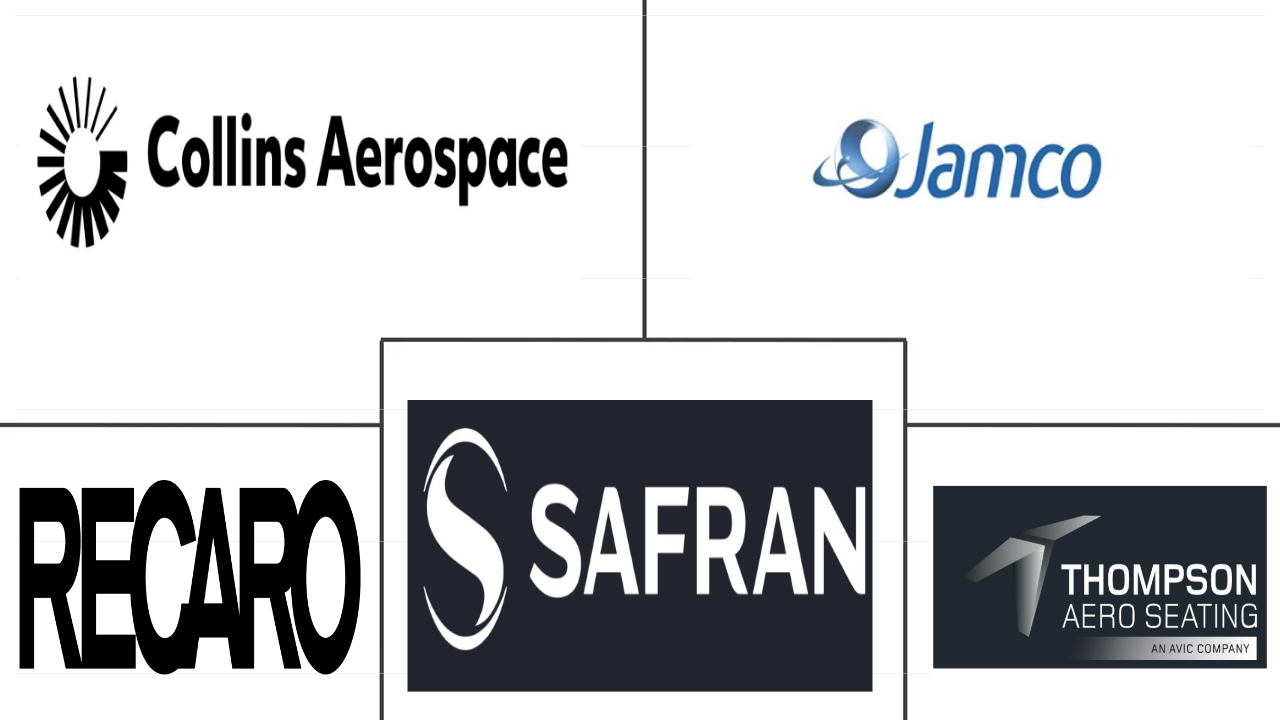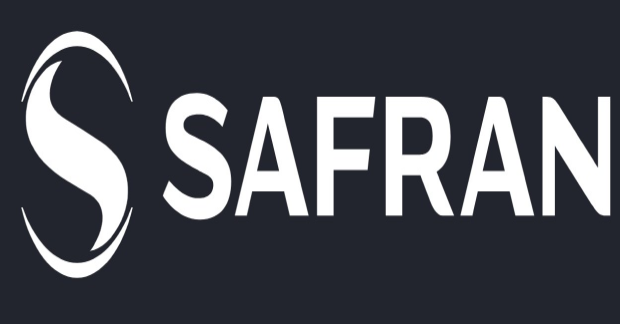Market Size of europe commercial aircraft cabin seating Industry
| Icons | Lable | Value |
|---|---|---|
|
|
Study Period | 2017 - 2030 |
|
|
Market Size (2024) | USD 409.6 Million |
|
|
Market Size (2030) | USD 504.6 Million |
|
|
Largest Share by Aircraft Type | Narrowbody |
|
|
CAGR (2024 - 2030) | 3.54 % |
|
|
Largest Share by Country | Germany |
|
|
Market Concentration | High |
Major Players |
||

|
||
|
*Disclaimer: Major Players sorted in no particular order |
Europe Commercial Aircraft Cabin Seating Market Analysis
The Europe Commercial Aircraft Cabin Seating Market size is estimated at 409.6 million USD in 2024, and is expected to reach 504.6 million USD by 2030, growing at a CAGR of 3.54% during the forecast period (2024-2030).
409.6 Million
Market Size in 2024 (USD)
504.6 Million
Market Size in 2030 (USD)
6.40 %
CAGR (2017-2023)
3.54 %
CAGR (2024-2030)
Largest Market by Aircraft Type
53.75 %
value share, Narrowbody, 2023
A fleet of narrowbody aircraft adds flexibility in terms of fleet management and helps reduce the operating costs of airlines, resulting in its rapid adoption. The demand for premium economy seats in low-cost carriers has increased.
Fastest-Growing Market by Aircraft Type
4.35 %
Projected CAGR, Widebody, 2024-2030
Widebody aircraft are designed primarily for long-haul flights. They have larger space to add more seats than narrowbody aircraft, resulting in the segment's rapid growth.
Largest Market by Cabin Class
52.18 %
value share, Business and First Class, 2023
The growing per capita income in developing countries and the increasing number of business-class seats globally have aided the growth of business and first-class categories.
Largest Market by Country
19.20 %
value share, Germany, 2023

The country is expected to register a major revenue share during 2024-2030 due to the increasing levels of air transportation and a rising number of commercial aircraft orders from major airlines.
Leading Market Player
43.63 %
market share, Safran, 2022

Safran dominates the European cabin seating market with its strong product portfolio of cabin seats for passenger aircraft. The company provides seats for the economy, premium economy, business, and first classes.
Europe is expected to experience a surge in demand for aircraft seats with improved technological features and enhanced passenger travel comfort
- Modern-generation aircraft seats are made from lightweight, non-metallic materials and have lightweight designs to reduce fuel expenses and increase the aircraft's sustainability. The demand for seats with enhanced features and technologically based convenience is increasing, which will accelerate market expansion in the future.
- An enhanced seating structure with more developed space than economy-class seats is becoming highly essential due to rising preferences for business-class travelers. Worldwide airline operators and OEMs are increasing their efforts to reduce weight and develop a sustainable way to manage the airline industry in consideration of the zero-emission 2050 goal.
- During 2017-2022, narrowbody aircraft accounted for the majority of deliveries, with 82% of the total aircraft delivered. As domestic demand has grown, the narrowbody segment is expected to grow at a faster rate than the widebody segment. In 2022, the procurement of new aircraft in the region exceeded the pre-pandemic levels by 38% compared to 2019.
- Factors such as the rising adoption of innovative cabin seats, the growing demand for luxury air travel, and the huge number of aircraft orders are expected to drive the market during the forecast period. On this note, as part of fleet expansion and the demand driven by new narrowbody aircraft with long range on major routes, airlines placed new orders, such as Rostec ordering 250 aircraft, Ryanair ordering 200 aircraft, and Wizz Air ordering 102 narrowbody aircraft. During 2023-2030, around 2,647 aircraft are to be delivered to the region, boosting the overall seating market in the region.
The surge in low cost carriers and demand for improved passenger seating experience is anticipated to aid the market growth in Europe
- The importance of comfortable seating in aircraft has increased. The major reason for this is to provide a better passenger experience. The increased passenger traffic drives the demand for new aircraft procurements, creating the need for a larger cabin interior market. Airline companies in the European region are implementing fleet expansion plans to cater to the growing air passenger traffic across major countries. The United Kingdom, Germany, and Russia are expected to generate the maximum demand for new aircraft compared to other European countries.
- Europe's three most prominent airline groups, Anglo-Spanish Multinational Airline IAG and Germany's Lufthansa & Air France have significantly improved their seating capacity in 2023, with healthy capacities across their route networks compared to 2022. Although these efforts have been stepped up, these carriers are still behind the levels they reached before the pandemic.
- .The commercial aircraft manufacturers, namely Boeing and Airbus, are expected to deliver many aircraft in the region. About 2,647 new jets are expected to be delivered across the region. Of these, 2354 jets are expected to be narrow-body aircraft. There is a high preference for smaller and more economical aircraft, along with the introduction of long-range narrow-body aircraft.
- The success of LCCs is high in this region. Major airline companies in the region, such as Air France, British Airways, and Lufthansa, focus on improving the overall passenger experience in the aircraft market. This is expected to aid the region's demand for commercial aircraft cabin interior products.
Europe Commercial Aircraft Cabin Seating Industry Segmentation
Narrowbody, Widebody are covered as segments by Aircraft Type. France, Germany, Spain, Turkey, United Kingdom are covered as segments by Country.
- Modern-generation aircraft seats are made from lightweight, non-metallic materials and have lightweight designs to reduce fuel expenses and increase the aircraft's sustainability. The demand for seats with enhanced features and technologically based convenience is increasing, which will accelerate market expansion in the future.
- An enhanced seating structure with more developed space than economy-class seats is becoming highly essential due to rising preferences for business-class travelers. Worldwide airline operators and OEMs are increasing their efforts to reduce weight and develop a sustainable way to manage the airline industry in consideration of the zero-emission 2050 goal.
- During 2017-2022, narrowbody aircraft accounted for the majority of deliveries, with 82% of the total aircraft delivered. As domestic demand has grown, the narrowbody segment is expected to grow at a faster rate than the widebody segment. In 2022, the procurement of new aircraft in the region exceeded the pre-pandemic levels by 38% compared to 2019.
- Factors such as the rising adoption of innovative cabin seats, the growing demand for luxury air travel, and the huge number of aircraft orders are expected to drive the market during the forecast period. On this note, as part of fleet expansion and the demand driven by new narrowbody aircraft with long range on major routes, airlines placed new orders, such as Rostec ordering 250 aircraft, Ryanair ordering 200 aircraft, and Wizz Air ordering 102 narrowbody aircraft. During 2023-2030, around 2,647 aircraft are to be delivered to the region, boosting the overall seating market in the region.
| Aircraft Type | |
| Narrowbody | |
| Widebody |
| Country | |
| France | |
| Germany | |
| Spain | |
| Turkey | |
| United Kingdom | |
| Rest of Europe |
Europe Commercial Aircraft Cabin Seating Market Size Summary
The Europe Commercial Aircraft Cabin Seating Market is poised for significant growth, driven by the increasing demand for modern, lightweight, and technologically advanced seating solutions. As airlines focus on enhancing passenger comfort and experience, the market is witnessing a shift towards more spacious and feature-rich seating, particularly in business class. This trend is further fueled by the rising preference for luxury air travel and the substantial number of aircraft orders, especially in the narrowbody segment, which is expected to outpace the widebody segment. The push towards sustainability and fuel efficiency, in line with the zero-emission goals for 2050, is also influencing the design and materials used in aircraft seating, contributing to the market's expansion.
The market landscape is characterized by a consolidation of major players, with companies like Collins Aerospace, Jamco Corporation, Recaro Group, Safran, and Thompson Aero Seating dominating the scene. These companies are actively involved in collaborations and innovations to meet the evolving demands of the aviation industry. The European region, being a significant hub for air travel, is witnessing a robust increase in air passenger traffic, which is driving the need for new aircraft and, consequently, new cabin seating solutions. The recovery in air travel post-pandemic and the strategic fleet expansions by major airlines are expected to further bolster the market, making Europe a key player in the global commercial aircraft cabin seating industry.
Europe Commercial Aircraft Cabin Seating Market Size - Table of Contents
-
1. MARKET SEGMENTATION (includes market size in Value in USD, Forecasts up to 2030 and analysis of growth prospects)
-
1.1 Aircraft Type
-
1.1.1 Narrowbody
-
1.1.2 Widebody
-
-
1.2 Country
-
1.2.1 France
-
1.2.2 Germany
-
1.2.3 Spain
-
1.2.4 Turkey
-
1.2.5 United Kingdom
-
1.2.6 Rest of Europe
-
-
Europe Commercial Aircraft Cabin Seating Market Size FAQs
How big is the Europe Commercial Aircraft Cabin Seating Market?
The Europe Commercial Aircraft Cabin Seating Market size is expected to reach USD 409.60 million in 2024 and grow at a CAGR of 3.54% to reach USD 504.55 million by 2030.
What is the current Europe Commercial Aircraft Cabin Seating Market size?
In 2024, the Europe Commercial Aircraft Cabin Seating Market size is expected to reach USD 409.60 million.

